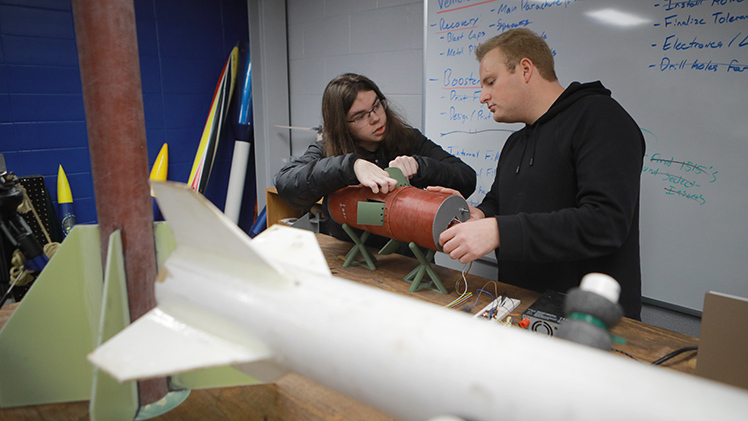There’s more to rocketry than dramatic countdowns and high-powered liftoffs.
Before any of that can happen at a launch site, there are reports to compile and present detailing the proposed design, the estimated costs, the anticipated schedule, an assessment of risks and more.

The UToledo Rocketry Club’s Matthew Lomax, a mechanical engineering freshman, and Brody Greenwood, a mechanical engineering senior, tinker with an air braking system that the team is designing for the rocket they will compete with in the 2025 NASA Student Launch Challenge.
The University of Toledo Rocketry Club is learning this firsthand as it prepares for one of these high-powered liftoffs this spring through NASA’s 25th annual Student Launch Challenge.
The team has tallied 500-plus typed pages of formal reports so far.
“It mimics a lot of the steps that aerospace companies like SpaceX or Blue Origin do when they submit bids to NASA,” Lucas Paskey, an electrical engineering senior, said of the nine-month process that began when the team received this year’s design criteria ahead of a proposal submission in September. “They’ll go through a preliminary design, and then they’ll go through a critical design and then they’ll actually submit a prototype to NASA.”
Paskey is president of the UToledo Rocketry Club, which is picking up momentum since he and Brody Greenwood, a mechanical engineering senior and vice president of the Rocketry Club, revived it three years ago following a pandemic hiatus. Without the tutelage of experienced upperclassmen to lean on, Greenwood and Paskey largely taught themselves the art and science of rocketry, leading the new team to compete in the Battle of the Rockets student competition in 2023, return to the NASA Student Launch Challenge in 2024 and now work hard on a bigger, better and more complex rocket for 2025.
“The Rocketry Club members work like a well-oiled machine, tackling every challenge with enthusiasm,” said Dr. George Choueiri, the faculty advisor for the UToledo Rocketry Club and an assistant professor in the Department of Mechanical, Industrial and Manufacturing Engineering. “When I attend their meetings and see how focused they are and how well they work together, I believe they can accomplish anything. I’m certain they will be very competitive in the NASA Student Launch.”
The NASA Student Launch Challenge tasks student teams from across the country with designing, building, testing and launching a high-powered rocket and scientific payload according to criteria that the space agency adjusts each year.
UToledo is one of 71 collegiate teams working out a communications system this year that will send real-time data from the rocket to a ground-based mission control, for example.
The 2025 NASA Student Launch Challenge begins Wednesday, April 30, and culminates on Sunday, May 4, with a final launch sending rockets between 4,000 and 6,000 feet into the air at a site just north of NASA’s Marshall Space Flight Center in Huntsville, Alabama.
UToledo will be competing with a fiberglass rocket standing more than 11 feet tall. Hyperion, as they’ve named it, is designed to reach 5,000 feet before drifting back to the ground under a parachute about a minute and a half later.
Judges will be looking at how closely their actual altitude and target altitude align. Those 500-plus pages of plans should ensure a perfect match, but the team also is designing an air braking system that they can deploy just in case they need it.
The Student Launch Challenge is the primary focus of the 30-member Rocketry Club, but it’s not all that they do. The team participates in community engagement, running demonstrations at events like last semester’s Rocket Scientist Weekend at Imagination Station. It also coordinates workshops to help members obtain certifications through the National Association of Rocketry.
Since the relaunch of the Rocketry Club, more than 20 members have obtained a Level 1 High Power Certification, which allows hobbyists to purchase high-powered rocket motors. Paskey and Greenwood are among them.
Both students arrived at UToledo with a fascination with rocketry. Greenwood grew up in a childhood bedroom decorated around a space theme; Paskey has been following SpaceX launches since he was in middle school.
With aspirations for careers in the aerospace industry, they said they appreciate the value of what they’re doing with the Rocketry Club — even in tediously proofreading a 251-page Critical Design Review, their most recent of three reports the team has submitted to NASA.
“Now when we go into the workforce, we know what to expect,” Paskey said. “The College of Engineering is big on making sure that students are ready to go as soon as they graduate. I think a club like ours really helps students prepare for that work experience.”
Greenwood, who completed one of at least three integrated co-op experiences at an aviation company in Kansas, offered a similar perspective.
“This is a great resume-builder,” he said. “When I’ve had interviews for my co-ops, they’re looking through my classes and my previous work experience and then they see rocketry. Everybody asks about rocketry.”